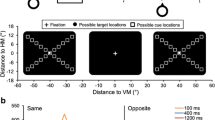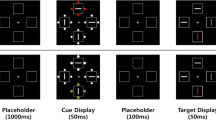Abstract
We investigated the cause(s) of two effects associated with involuntary attention in the spatial cueing task: contingent capture and inhibition of return (IOR). Previously, we found that there were two mechanisms of involuntary attention in this task: (1) a (serial) search mechanism that predicts a larger cueing effect in reaction time with more display locations and (2) a decision (threshold) mechanism that predicts a smaller cueing effect with more display locations (Prinzmetal et al. 2010). In the present study, contingent capture and IOR had completely different patterns of results when we manipulated the number of display locations and the presence of distractors. Contingent capture was best described by a search model, whereas the inhibition of return was best described by a decision model. Furthermore, we fit a linear ballistic accumulator model to the results and IOR was accounted for by a change of threshold, whereas the results from contingent capture experiments could not be fit with a change of threshold and were better fit by a search model.







Similar content being viewed by others
Notes
We used software kindly provided to us by Casimir Ludwig.
References
Al-Aidroos N, Guo RM, Pratt J (2010a) You can’t stop new motion: attentional capture despite a control set for colour. Visl Cogn 18(6):859–880
Al-Aidroos N, Harrison S, Pratt J (2010b) Attentional control settings prevent abrupt onsets from capturing visual spatial attention. Q J Exp Psychol 63(1):31–41
Ansorge U, Heumann M (2003) Top-down contingencies in peripheral cuing: the roles of color and location. J Exp Psychol Human 29(5):937–948
Bacon WF, Egeth HE (1994) Overriding stimulus-driven attentional capture. Percept Psychophys 55(5):485–496
Bartolomeo P, Decaix C, Siéroff E (2007) The phenomenology of endogenous orienting. Conscious Cogn 16(1):144–161
Berger A, Henik A, Rafal R (2005) Competition between endogenous and exogenous orienting of visual attention. J Exp Psychol Gen 134(2):207–221
Brown S, Heathcote A (2005) A ballistic model of choice response time. Psychol Rev 112(1):117–128
Brown SD, Heathcote A (2008) The simplest complete model of choice response time: linear ballistic accumulation. Cognitive Psychol 57(3):153–178
Burnham BR (2007) Displaywide visual features associated with a search display’s appearance can mediate attentional capture. Psychon Bull Rev 14(3):392–422
Donkin C, Brown S, Heathcote A, Wagenmakers E (2011) Diffusion versus linear ballistic accumulation: different models but the same conclusions about psychological processes? Psychon Bull Rev 18(1):61–69
Dosher BA, Han S, Lu ZL (2004) Parallel processing in visual search asymmetry. J Exp Psychol Human 30(1):3–27
Esterman M, Prinzmetal W, Degutis J, Landau A, Hazeltine E, Verstynen T, Robertson L (2008) Voluntary and involuntary attention affect face discrimination differently. Neuropsychologia 46(4):1032–1040
Folk CL, Remington RW, Johnston JC (1992) Involuntary covert orienting is contingent on attentional control settings. J Exp Psychol Human 18:1030–1044
Folk CL, Remington RW, Wright JH (1994) The structure of attentional control: contingent attentional capture by apparent motion, abrupt onset, and color. J Exp Psychol Human 20(2):317–329
Funes MJ, Lupianez J, Milliken B (2007) Separate mechanisms recruited by exogenous and endogenous spatial cues: evidence from a spatial Stroop paradigm. J Exp Psychol Human 33(2):348–362
Gibson BS, Amelio J (2000) Inhibition of return and attentional control settings. Percept Psychophys 62(3):496–504
Grice GR (1968) Stimulus intensity and response evocation. Psychol Rev 75(5):359–373
Ivanoff J, Klein RM (2001) The presence of a nonresponding effector increases inhibition of return. Psychon Bull Rev 8(2):307–314
Jonides J (1976) Voluntary versus reflexive control of the mind’s eye’s movement. Paper presented at the meeting of the Psychonomic Society, St Louis
Jonides J (1981) Voluntary versus automatic control over the mind’s eye’s movement. In: Long JB, Baddeley AD (eds) Attention and performance IX. Erlbaum, Hillsdale, pp 187–204
Kincade JM, Abrams RA, Astafiev SV, Shulman GL, Corbetta M (2005) An event-related functional magnetic resonance imaging study of voluntary and stimulus-driven orienting of attention. J Neurosci 25(18):4593–4604
Klein RM, MacInnes WJ (1999) Inhibition of return is a foraging facilitator in visual search. Psychol Sci 10(4):346–352
Klein RM, Taylor TL (1994) Categories of cognitive inhibition with reference to attention. In: Dagenbach D, Carr TH (eds) Academic Press, chap 133, pp 133–150
Landau AN, Esterman M, Robertson LC, Bentin S, Prinzmetal W (2007) Different effects of voluntary and involuntary attention on EEG activity in the gamma band. J Neurosci 27(44):11986–11990
Ludwig CJH, Farrell S, Ellis LA, Gilchrist ID (2009) The mechanism underlying inhibition of saccadic return. Cognitive Psychol 59(2):180–202
Lupiáñez J, Milan EG, Tornay FJ, Madrid E, Tudela P (1997) Does IOR occur in discrimination tasks? Yes, it does, but later. Percept Psychophys 59(8):1241–1254
Maylor EA, Hockey R (1985) Inhibitory component of externally controlled covert orienting in visual space. J Exp Psychol Human 11:777–787
Mordkoff JT, Halterman R, Chen P (2008) Why does the effect of short-SOA exogenous cuing on simple RT depend on the number of display locations? Psychon Bull Rev 15(4):819–824
Nelder JA, Mead R (1965) A simplex method for function minimization. Comput J 7(4):308–313
Posner MI (1980) Orienting of attention. Q J Exp Psychol-A 32:3–25
Posner M, Boies S (1971) Components of attention. Psychol Rev 75:391–408
Posner MI, Cohen Y (1984) Components of visual orienting. In: Bouma H, Bouwhuis DG (eds) Attention and performance X. Lawrance Erlbaum, Hillsdale, pp 531–556
Pratt J, Adam JJ, McAuliffe J (1998) The spatial relationship between cues and targets mediates inhibition of return. Can J Exp Psychol 52(4):213–216
Pratt J, Sekuler AB, McAuliffe J (2001) The role of attentional set on attentional cueing and inhibition of return. Vis Cogn 8(1):33–46
Prinzmetal W, Park S, Garrett R (2005) Involuntary attention and identification accuracy. Percept Psychophys 67(8):1344–1353
Prinzmetal W, Zvinyatskovskiy A, Gutierrez P, Dilem L (2009) Voluntary and involuntary attention have different consequences: the effect of perceptual difficult. Q J Exp Psychol-A 62(2):352–369
Prinzmetal W, Ha R, Khani A (2010) The mechanisms of involuntary attention. J Exp Psychol Human 36(2):255–267
Ratcliff R, Rouder JN (1998) Modeling response times for two-choice decisions. Psychol Sci 9(5):347–356
Rauschenberger R (2003) Attentional capture by auto- and allo-cues. Psychon Bull Rev 10(4):814–842
Reuter-Lorenz PA, Jha AP, Rosenquist JN (1996) What is inhibited in inhibition of return? J Exp Psychol Hum Percept Perform 22(2):367–378
Ruz M, Lupianez J (2002) A review of attentional capture: on its automaticity and sensitivity to endogenous control. Psicologica 23(2):283–309
Smith PL, Ratcliff R (2009) An integrated theory of attention and decision making in visual signal detection. Psychol Rev 116(2):283–317
Smith PL, Ratcliff R, Wolfgang BJ (2004) Attention orienting and the time course of perceptual decisions: response time distributions with masked and unmasked displays. Vision Res 44(12):1297–1320
Theeuwes J (2004) Top-down search strategies cannot override attentional capture. Psychon Bull Rev 11(1):65–70
Usher M, McClelland JL (2001) The time course of perceptual choice: the Leaky, competing accumulator model. Psychol Rev 108(3):550–592
Vandekerckhove J, Tuerlinckx F (2008) Diffusion model analysis with MATLAB: a DMAT primer. Behav Res Methods 40(1):61–72
Weger UW, Abrams RA, Law MB, Pratt J (2008) Attending to objects: endogenous cues can produce inhibition of return. Vis Cogn 16(5):659–674
Wright RD, Richard CM (2000) Location cue validity affects inhibition of return of visual processing. Vision Res 40(17):119–126
Acknowledgments
We would also like to thank Casimer Ludwig for providing software for the LBA modeling and for his generous advice and assistance.
Author information
Authors and Affiliations
Corresponding author
Rights and permissions
About this article
Cite this article
Prinzmetal, W., Taylor, J.A., Myers, L.B. et al. Contingent capture and inhibition of return: a comparison of mechanisms. Exp Brain Res 214, 47–60 (2011). https://doi.org/10.1007/s00221-011-2805-x
Received:
Accepted:
Published:
Issue Date:
DOI: https://doi.org/10.1007/s00221-011-2805-x




